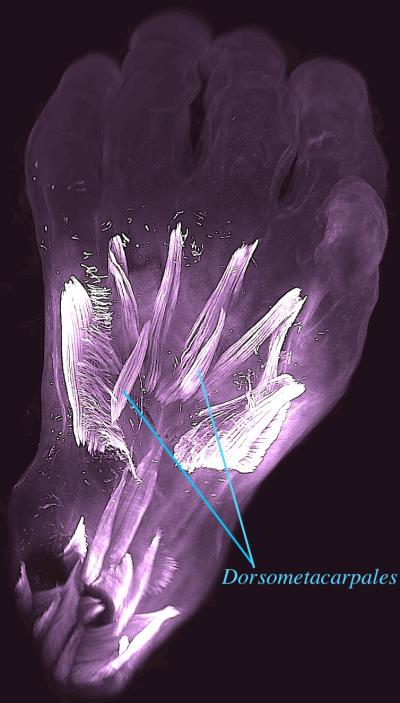|
|
Developmental Biology - Muscle
Our Muscles Reveal An Ancient Past
250-million-year-old evolutionary remnants seen in muscles of human embryos...
A team of evolutionary biologists, led by Rui Diogo PhD, Howard University, Washington, DC, USA, and writing in the journal Development, have shown how numerous atavistic limb muscles — known to be present in many limbed animals but usually absent in human adults — are actually formed during early human embryo development and lost prior to birth.
Strikingly, some of these muscles, such as the dorso-metacarpales shown in this photo, disappeared from our adult ancestors more than 250 million years ago, during the transition from synapsid reptiles to mammals.
Remarkably, in both the hand and the foot, of the 30 muscles formed at about 7 weeks of human gestation — one third will become fused or completely absent by about 13 weeks of gestation.
This dramatic decrease parallels what happened in evolution and deconstructs the myth that in both human evolution and prenatal development, humans tend to become more complex. It suggests more of our anatomical structures — like our muscles — continuously form by from the splitting of earlier muscle designs. The new observations give insight into how our arms and legs evolved from our ancestors' limbs, and also about human variation today and even certain pathologies. Atavistic muscles are often found either as rare variations in the common human population or sometimes as anomalies in humans born with "congenital malformations."
Since Darwin proposed his evolutionary theory, scientists have argued that the occurrence of atavistic structures (anatomical structures lost in the evolution of a certain group of organisms that can be present in their embryos or reappear in adults as variations or anomalies) strongly supports the idea that species change over time from a common ancestor through "Descent with Modification."
For example, ostriches and other flightless birds have vestigial wings, while whales, dolphins and porpoises lack hind limbs, even as their embryos initiated and then stopped their hind limb development. Similarly, temporary small tail-like structures are found in human embryos, with the remnant of our lost ancestral tail retained as our coccyx.
Researchers have always suggested atavistic muscles and bones can be seen in human embryos. But, it is difficult to visualize these structures clearly. Images that appear in modern textbooks are mainly based on decades old analyses.
This is changing with new technologies that provides high-quality 3D images of human embryos and fetuses. In the new study, the authors used these technologies to produce the first detailed image analysis of human arm and leg muscle development. The unprecedented resolution offered by these 3D images reveals the transient presence of several atavistic muscles.
"It used to be that we had more understanding of the early development of fish, frogs, chicken and mice than our own species. But, these new techniques allow us to see human development in much greater detail. What is fascinating is that we observed various muscles never described in human prenatal development. Some of these atavistic muscles are seen even in 11.5-weeks old fetuses — strikingly late for developmental atavisms.
"Interestingly, some atavistic muscles are found on rare occasions in adults. Either as anatomical variations without any noticeable effect for a healthy individual, or as the result of investigation of congenital malformations. This reinforces the idea that both muscle variations and pathologies can be related to delayed or arrested embryonic development. Perhaps a delay or decrease of muscle apoptosis helps explain why such muscles are occasionally found in adults. Providing a fascinating, powerful example of evolution in play."
Rui Diogo PhD,
Department of Anatomy, Howard University College of Medicine, Washington, DC, USA.
Abstract
We provide the first detailed ontogenetic analysis of human limb muscles using whole-mount immunostaining. We compare our observations with the few earlier studies that have focused on the development of these muscles, and with data available on limb evolution, variations and pathologies. Our study confirms the transient presence of several atavistic muscles – present in our ancestors but normally absent from the adult human – during normal embryonic human development, and reveals the existence of others not previously described in human embryos. These atavistic muscles are found both as rare variations in the adult population and as anomalies in human congenital malformations, reinforcing the idea that such variations/anomalies can be related to delayed or arrested development. We further show that there is a striking difference in the developmental order of muscle appearance in the upper versus lower limbs, reinforcing the idea that the similarity between various distal upper versus lower limb muscles of tetrapod adults may be derived.
Authors
Rui Diogo, Natalia Siomava and Yorick Gitton.
Acknowledgements
The authors declare no competing or financial interests.
This research received no specific grant from any funding agency in the public, commercial or not-for-profit sectors.
Author contributions
Conceptualization: Rui Diogo; Methodology: Rui Diogo, Natalia Siomava, Yorick Gitton; Formal analysis: Rui Diogo, Natalia Siomava; Investigation: Rui Diogo; Writing - original draft: Rui Diogo; Writing - review & editing: Rui Diogo, Natalia Siomava, Yorick Gitton; Visualization: Natalia Siomava, Yorick Gitton; Supervision: Rui Diogo
Funding
This research received no specific grant from any funding agency in the public, commercial or not-for-profit sectors.
Return to top of page.
| |
|
Oct 2 2019 Fetal Timeline Maternal Timeline News
 Dorsal view of the left hand of a 10-week old human embryo. The dorsometacarpales are highlighted: these muscles (like others described in this study) are present in adults of many other limbed animals, while in humans they normally disappear or become fused with other muscles before birth. CREDIT
Rui Diogo, Natalia Siomava and Yorick Gitton.
|



